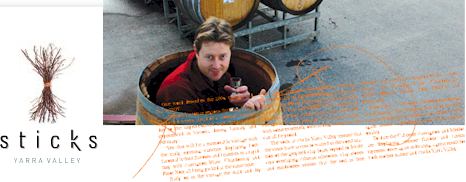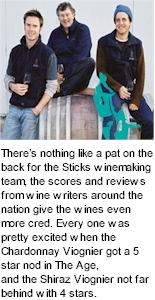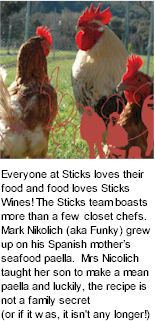


Rob Dolan’s career in the wine industry began in South Australia where he learned the art of winemaking from a couple of well-known teachers in Greg Clayfield and John Vickery at Rouge Homme. After studying at Roseworthy Agricultural College Rob began making wine in the Hunter Valley with Arrowfield and Rothbury Estate. In 1991 Rob became winemaker at Yarra Ridge. Here, the opportunity of operating a small winery gave him the freedom to experiment, helping him to hone his winemaking skills.

These skills were soon rewarded on the National show circuit where he won numerous trophies and gold medals including the top gold medal at the Royal Melbourne Wine Show and placing in the Jimmy Watson taste-off. Internationally, Rob won the prestigious Bouchard-Finlayson Trophy for Champion Pinot Noir at the 1999 International Wine and Spirit Show in London.
After years of winemaking for the big boys, Rob “Sticks” Dolan was ready to put his name to a new style of Yarra Valley wines. The Sticks style is fresh, fruit driven, great with food, affordable and hand made. In a few short years, Rob and his team created one of Australia’s best-known value wine brands – available worldwide and all crafted in the heart of Victoria’s Yarra Valley. And why the name Sticks? At 6 foot 6, this was Rob’s nickname, back in the days when his life centred on playing Australian Rules Football for Port Adelaide. That was a few years ago now…
It’s a cliché but it’s true, great wines begin in the vineyard. Sticks draws fruit from the estate Home Vineyard at Glenview Road in Yarra Glen, and from valued Yarra Valley growers. At sixty acres, initially planted in 1983, the entire Home Vineyard is now fully mature and offers the full spectrum of winemaking options. Various trellis methods are employed, Geneva Double Curtain, Lyre Trellis, Scott Henry, Vertical Shoot Positioning and Hanging cane. Very few vineyards have this range of trellises – making the Sticks Home Vineyard unique, and frequently visited by neighbouring viticulturalists. Planted to Sauvignon Blanc, Chardonnay, Viognier, Pinot Noir, Cabernet Sauvignon, Shiraz, Petit Verdot and Merlot, he site is drip irrigated from the property’s dams, with sixty five megalitres capacity in total.

The soil profiles on the Home Vineyard are grey to red clay loam topsoil (30-40 centimetres) overlaying Silurian siltstones, clay stones and mudstones. The site's free draining soil directs nutrients to developing fruit flavour, rather than vigorous leaf growth. The microclimate here is cool by Australian standards, yet warmer than Burgundy and cooler than Bordeaux. The Yarra Valley’s mean temperature of the warmest month (January) is 19.4 degree Celsius, and rainfall averages to twenty eight inches per year.
To keep up with demand, Sticks also draws fruit from twenty select growers, in and around the Yarra Valley. These growers are a vital part of the Sticks team. All are committed and dedicated to producing the best fruit possible. Sticks has worked with these guys for a long time and has developed strong friendships with them all – they’re regulars on Sticks Dolan's tasting days around cellar door, and at staff barbies. It’s a long term partnership that Sticks enjoys with the growers…one which shows in the Sticks Wines.
Sticks white grapes are hand harvested from late February to early March and always in the cool of the morning or night. Fresh is best, so the fruit is rushed to the winery for crushing, pressing and juice settling. Fermenting at cool temperatures captures the flavour and personality of the Sticks whites. The Sauvignon Blanc spends all its time in stainless steel vat, while the Chardonnay is treated to a touch of barrel fermentation and maturation. "Chardonnay and Viognier are proving great team-mates as shown in this fresh, fruity wine, which has lemon, white peach and apricot aromas and flavours. Drink now!" -Sunday Age
Just like the whites, the reds are harvested during the night or early in the morning. The Pinot Noir ripens first – around the same time as the whites – and Sticks is highly selective about what can be accepted when it comes to Pinot Noir. After all, it accounts for half the red wine production and many of the estate's growers exclusively grow Pinot Noir for Sticks. Shiraz and Cab come in later – towards the end of March. The main difference between white and red winemaking is that the reds include skins in the fermentation. The skins hold all the flavour and colour. Once fermentation is over, Sticks reds mature in French oak before bottling.
